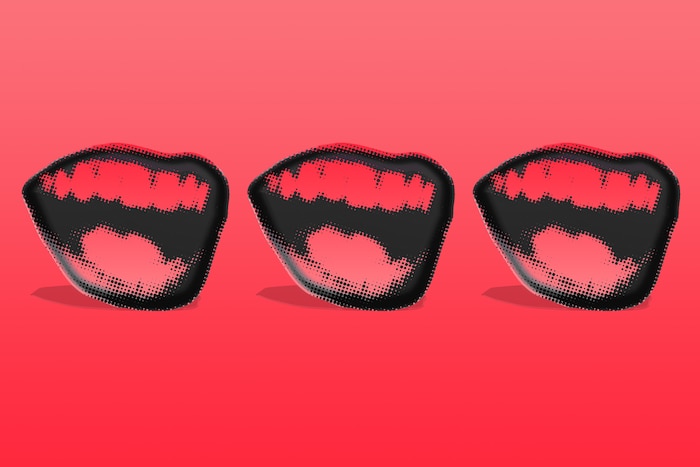Key 1999 Tracks: Le Tigre’s “Deceptacon”
Sasha Geffen delves into the history and impact of the 1999 political pop song that helped usher in the electroclash era

Just before dusk in the thick of a Chicago summer, Arca sends Kathleen Hanna’s voice screaming through the waterlogged air. It’s day two of the 2017 Pitchfork Music Festival, and the Venezuelan producer, known for sticky beats and detuned synths, is not so much playing a set of original music as DJing the party happening on the ground. No one expects “Deceptacon,” but there it is, a roughshod electric chomp of a song that sounds as fiery in this century as it did at the tail end of the last. Of course one of the most provocative electronic musicians of this decade would adore Le Tigre’s spiny irreverence. Arca pops open a bottle of Veuve Clicquot and lets the front row marinate in the spray. Like the rest of us, Arca dances to the song’s unmistakable bass throb.
Released in 1999 at the top of Le Tigre’s debut self-titled album, “Deceptacon” would prove to be a rallying cry for a whole new generation of queers, women and other marginalized young shitstarters. Fronted by Hanna, a blowtorch of a singer who had left her band Bikini Kill in 1996, Le Tigre imported riot grrrl’s punk spikes to the comparatively young field of homespun electronic music. Eight-bit samplers and four-track recorders were as cheap as they’d ever been, while music software like Pro Tools was growing in popularity as a producer’s weapon of choice. Home computer users may have still been funneling the web through their phone lines, but the internet was emerging as a new and potentially utopian mode of mass communication. Before it got completely ensnared in the clutches of bad faith technocrats, digital technology felt like a bright and shiny gateway into the next millennium. The time was right for a DIY feminist pop band.
We want to write political pop songs and be the dance party after the protest.
After quitting Bikini Kill, Hanna retreated from the scene and released a record of sampler-based solo music under the name Julie Ruin in 1997. Tired of performing her anger over blistering power chords for most of the ’90s, Hanna was ready to try joy. She moved out of D.C.’s blunt-force approach to political music and started working in a mode more aligned with her new home of New York. While putting together a band to help her perform her new music, she found herself forming a new group with Johanna Fateman and Sadie Benning. They called themselves Le Tigre, and set about making feminist jams that could scorch a dancefloor. “People would come up and be like, ‘Why aren’t you angry anymore?’” Hanna said in a 2019 Gusher interview. “I’m totally fucking angry. That’s just not how I’m singing right now. I had to get to a place where I could celebrate the achievements that I’ve made, because I was just depressed.”
In a 2019 Red Bull Radio Fireside Chat, Hanna explained more her mindset at the end of the ’90s: “Let’s just make something totally happy that’s a gift about everything great that’s happened,” she said. “We want to write political pop songs and be the dance party after the protest.”
A year before the Avalanches released the plunderphonics classic Since I Left You, Le Tigre established their own collaging practice. “Sadie and I spent time just collecting samples and creating libraries for ourselves,” Fateman tells me over the phone. “Every once in a while, we would spend a couple hours going through records or VHS tapes or whatever sound sources we could find. We would sample a note from a record and then detune it to make a melody. We weren’t necessarily using it as a form of quotation as much as we were collecting sounds we could use. Because we didn’t have a lot of synthesizers or a lot of things to make sounds with, we would find these weirdly textured things and just play them on different keys.”
Le Tigre’s unconventional sound-sourcing strategy complemented their renegade approach to writing. “Deceptacon” doesn’t really have a chorus. Because it revolves around a single four-note bassline and its structure never shifts from bedrock, every single element that comes in hits like a barbed hook. The sampled handclaps, the guitar riff (there’s only one, and it gets sped up to a hilarious clip for the “noodly” parts), the “who took the bomp” (a play on Barry Mann’s 1961 hit “Who Put the Bomp (in the Bomp, Bomp, Bomp)”), all crash into the ear in such a whirlwind that the ear craves more of them. These disparate sound bites, plumbed from far-flung sources, tug on your attention like a bee sting. Instead of playing to the tension and release that govern traditional pop songs, Le Tigre aimed a candy-crusted torpedo straight at their listeners’ pleasure centers.
If Bikini Kill distilled the pain of living under patriarchy into bursts of righteous fury, then Le Tigre subsumed that pain into the catharsis of pleasure.
“There’s none of what you’re supposed to have to build excitement in a pop song. There is none of the pathos of a key change,” says Fateman. “It’s on or off. That’s the structure. We were trying to make different kinds of songs about different feelings and different ideas that weren’t in pop music or punk music at that time.”
If Bikini Kill distilled the pain of living under patriarchy into bursts of righteous fury, then Le Tigre subsumed that pain into the catharsis of pleasure, a strategy deployed to great effect in New York’s disco clubs in the ’70s. “Wanna disco? Wanna see me disco?” Hanna screams in “Deceptacon’s” first verse, as if daring her listeners to re-politicize the corporate, sanitized history of dance music. Before the Bee Gees whitewashed it, disco was survival for queer communities of color. It signified safety during a time when gay bars were outlawed in New York.
“We knew [‘Deceptacon’] was catchy. It felt like an icebreaker. I remember having a strong feeling it should be the first song,” Fateman continues. “It came to be our most popular song, so in that way it became anthemic. Early on, for some people, it recalled the Bikini Kill era – it was a familiar reference point for people who knew about us from that connection. But then it became its own thing. People like that song but don’t know about Bikini Kill or riot grrrl at all. It’s kind of a ‘fuck you’ song. That’s a classic trope.”
After George W. Bush ascended to the presidency in 2000 and promptly plunged the US into a state of total war, detached escapism became the mode du jour of both mainstream and underground music cultures. Le Tigre’s strategy of layering fierce punk vocals over electronic whimsy crystallized into what came to be known as electroclash, a brief but bright-burning aughts microgenre that cleared open space for groundbreaking artists like Alice Glass and Grimes. There’s a little of “Deceptacon” in the latter artist’s breakthrough 2012 record Visions, in the way basslines bubble and vocals sputter and squall. Grimes famously assembled that album in GarageBand, Apple’s glossy digital answer to the four-track tape machine. Like Le Tigre, Visions proved you didn’t need to be a man to slap together a walloping computerized beat, even if the conceit that women sing and men produce lingered after its release. “I’m tired of men who aren’t professional or even accomplished musicians continually offering to ‘help me out’ (without being asked), as if I did this by accident and I’m gonna flounder without them,” Grimes wrote in a 2013 Tumblr post.
The futurity promised by turn-of-the-millennium digital culture has more or less putrefied into startups and surveillance. Computers of all sizes have started to feel more like a Sisyphean burden than a portal into a brave new world. But the music they enable – the hyperreal textures that slink out of soft synths, the towering monolithic drums, the syrupy, slowed-down vocals – all that still sounds like the future.
Many of this era’s most adventurous artists cite Le Tigre as a fomenting influence. As well as the aforementioned, in a 2016 interview with Milk, multidisciplinary queer artist Colin Self said, “By the time I was 13/14 years old, I’d seen people like Le Tigre and Sleater-Kinney perform live, all of these riot grrrl bands. Essentially I remember being like: ‘that’s what I’m going to do with the rest of my life.’” In 2014, queer rapper Mykki Blanco recruited Hanna for a song on the mixtape Gay Dog Food. The track, “A Moment With Kathleen,” begins with the sound of Blanco freaking out about getting to meet his idol.
It follows, in retrospect, that a micromovement of gender-weird geniuses would find life in Le Tigre. Songs like “Deceptacon” split apart the expected structure of the electronic pop song and stitched it back together deliriously and delightfully wrong. “It sounds outdated to talk about stuff like this, but we were really into quote-unquote deconstruction,” says Fateman. “Deconstructing a song in the sense of taking little samples from it and building something else, but also in the more conceptual sense of: what is a song? What is rock music? What is a band? All of the masculinist values that run through that stuff at every level, at the level of who plays guitar, who made this note – that’s what we thought about all the time.”
Sometimes bands send Fateman note-for-note rock covers of “Deceptacon.” The song’s quick, squiggly guitar part, the one made from a slow riff sped up, gets played in a flash across the fretboard, a masculinist display of technical dexterity. The song has resonated even among those who miss the point. “It’s just like, well, you kind of negated the content of the song!” Fateman says. “But it sounds the same if you like bar bands.”
The point is that anyone can borrow the chorus to a 1961 heteronormative love song and turn it into a rallying cry for feminine independence. The point is that no matter the tools available to you, chaos belongs anywhere you can cram it. Decades after Le Tigre’s debut, queer electropunks still carry “Deceptacon’s” flaming torch.

